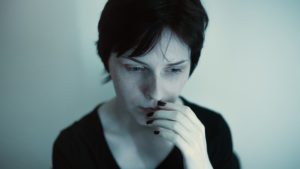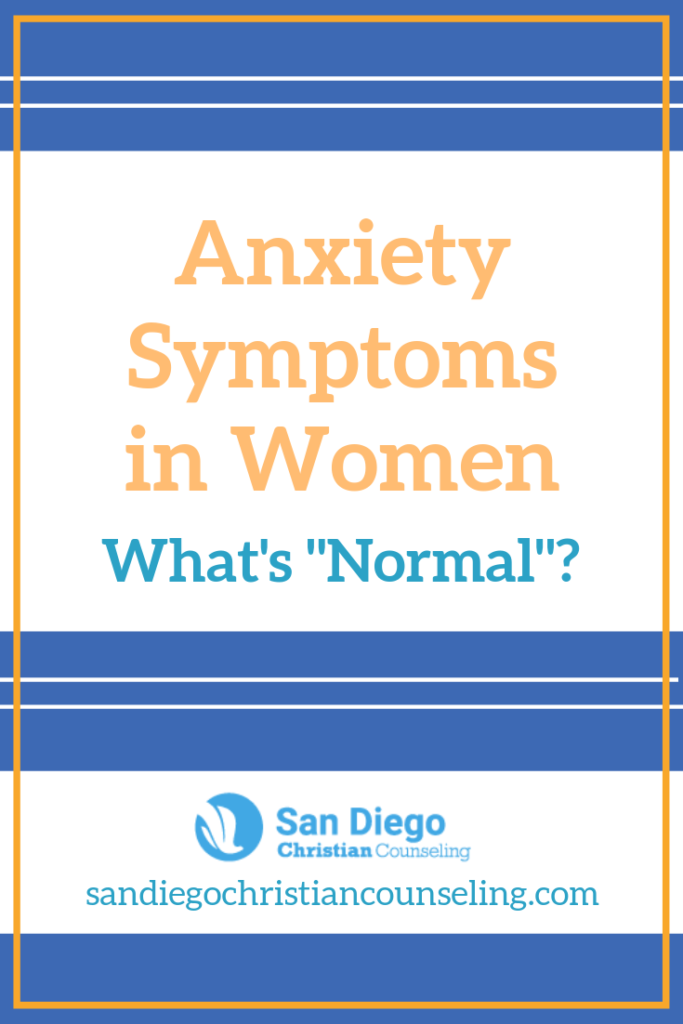 Did you know that even though anxiety affects both genders at all ages, anxiety symptoms in women are different from anxiety symptoms in men?
Did you know that even though anxiety affects both genders at all ages, anxiety symptoms in women are different from anxiety symptoms in men?
Anxiety also manifests differently depending on how old the person is. Symptoms of anxiety in children and younger teens are usually some type of phobia or incessant worry. Young adults are most likely to experience PTSD, and older adults are most prone to panic disorders and generalized anxiety. San Diego Christian Counseling can help address these age-specific anxiety issues.
Yes, men experience anxiety; however, women are twice as likely to suffer anxiety, and anxiety disorders are much more prevalent in women than men. Anxiety in both men and women is often missed by physicians and mental health professionals, as many of the symptoms can be misdiagnosed as other health issues.
Which anxiety disorders most commonly affect women in their 30’s and 40’s?
- Generalized anxiety
- Panic attacks
- PTSD (Post-traumatic Stress Disorder)
Why are midlife women more likely to be afflicted by these disorders?
The hormonal fluctuations of childbirth, pre-menopause, and menopause are a plausible factor in anxiety. Midlife is also an especially demanding time for women. At this age, most women have children to care for, and probably aging parents. Many women are climbing the ladder in their career and balancing the stresses of family life and work.
 The requirements of raising children can be a daunting task for mothers. Women also feel pressured to maintain immaculate and stylish homes, hair, nails, and clothes, to stay in good physical shape, to advance in their careers, to have an active social life and to engage in church, community, and volunteer activities, not to mention nurturing a marriage!
The requirements of raising children can be a daunting task for mothers. Women also feel pressured to maintain immaculate and stylish homes, hair, nails, and clothes, to stay in good physical shape, to advance in their careers, to have an active social life and to engage in church, community, and volunteer activities, not to mention nurturing a marriage!
Anxiety in mid-life women in mid-life can often simply be due to the stress of trying to squeeze too many responsibilities into 24 hours. Women also tend to compare themselves to other women their age and become self-condemning as a result. They may have negative “self-talk” that sounds something like this:
- Everyone else here looks so thin! I’m the fattest person here. And look at her boots and her hair! I wish I’d done more with my hair before I left the house!
- She always seems to glide effortlessly through work, church, and home. I need to be more like her! What’s her secret?
- Oh! Look at her Facebook photos! Her husband seems to really dote on her! And they’re in France! They always have such glamorous vacations! All we ever do is visit the in-laws!
Another cause of anxiety disorder in some mid-life women is abuse that they suffered as a child, adolescent or young adult that can result in PTSD episodes years after the violence occurred. Females are more likely to be the victims of sexual abuse and violence, and random events or places can trigger latent memories.
Common Anxiety Symptoms in Women
If you’re a woman in your 30’s or 40’s, you may be experiencing symptoms of an anxiety disorder. You may have a vague feeling that something’s wrong, but not sure what. Let’s take a look at the three most common anxiety disorders in mid-life women and what the symptoms are.

Generalized Anxiety Disorder Symptoms
People with Generalized Anxiety Disorder experience incessant worry about many different things – their own health, their children’s health, their career, relationships, finances, relationships, and so forth.
We all worry about these things from time to time, but someone with Generalized Anxiety Disorder literally feels compelled to worry – to stew over every concern to the point where they’re not able to enjoy or engage in life very much.
Someone with Generalized Anxiety Disorder is ruled by anxiety. They can’t snap out of it by distracting themselves with other things or trying to be more realistic. They blow actual concerns out of proportion or even worry about things that aren’t really a problem. They often imagine the worst-case scenario and have a sense of impending doom.
People with Generalized Anxiety Disorder have at least three of the following symptoms that occur regularly and persist for at least six months:
- Inability to relax and enjoy the moment
- Fidgety, nervous, edgy, easily startled, or tense
- Difficulty focusing and staying on task, mind “goes blank”
- Sleep issues: trouble falling asleep, mind racing, waking up with obsessive thoughts and not being able to fall asleep again.
- Fatigue, sleepiness
- Muscle tension and muscle aches
- Sweating
- Stomach problems – nausea, diarrhea
- Increased heart rate, hyperventilating
Panic Disorder Symptoms
People with panic disorder have unexpected and intense fear that comes on suddenly, usually brought on by some trigger, and generally resolves within ten minutes or so.
Psychological symptoms include:
- The sense of impending doom
- Feelings like everything is surreal
- Feeling like you’re going crazy or losing control
- Feeling like you’re going to die or pass out
- Feeling like you need to escape
Physical symptoms include:
- Racing or pounding heart and/or irregular heart rate
- Chest pain or pressure
- Trembling or shaking
- Shortness of breath or choking feeling
- Feeling weak or lightheaded
- Feeling hot and sweaty or chills
- Nausea, vomiting and/or abdominal pain
- Feeling numbness or tingling or “pins and needles” on the skin, especially in hands and feet.
 People who have panic attacks begin to have anxiety about having another one, which leads to avoidance behavior – trying to stay away from the trigger that caused a previous attack. Avoidance behavior can quickly lead to a significantly altered lifestyle.
People who have panic attacks begin to have anxiety about having another one, which leads to avoidance behavior – trying to stay away from the trigger that caused a previous attack. Avoidance behavior can quickly lead to a significantly altered lifestyle.
Panic attacks are often undiagnosed because a number of the symptoms mimic heart issues, respiratory disorders, and other health problems. If you are a woman in your 30’s or 40’s and have had at least four of the above symptoms at one time, you may have been having a panic attack.
Post Traumatic Stress Disorder (PTSD) Symptoms
PTSD symptoms will manifest for at least a month after a person experiences some sort of trauma: such as witnessing a sudden or violent death, being the victim of a violent attack, observing the results of violence in victims – especially in situations such as soldiers in a war zone, first responders to accident or crime scenes, or emergency room personnel.
PTSD may lie dormant for years, even decades, and then symptoms might surface due to another trauma in the person’s life, or having one’s memory jogged by some sort of experience.
PTSD is characterized by the following dominant symptoms:
- One finds they are reliving the trauma in some way, such as through sudden and distressing memories, nightmares, or flashbacks.
- One goes to great lengths to avoid memory triggers – such as people, places or situations that are associated with the trauma, as exposure to triggers causes extreme distress.
- One persistently has negative emotions and beliefs, such as believing the world is an unsafe place, blaming yourself or others for the trauma, emotional numbness, detachment, disinterest in activities, inability to feel positive emotions, and commonly experiencing feelings of shame, horror, or fear.
- One has significant changes in reactions and arousal, such as difficulty focusing, disruption to sleep, feeling nervous and very easily startled, irritated by minor things, outbursts of anger, aggressive behavior, and self-destructive behavior
 About half of all women have experienced trauma of some sort. Women and men tend to experience different types of trauma, and they also usually manifest different symptoms of PTSD.
About half of all women have experienced trauma of some sort. Women and men tend to experience different types of trauma, and they also usually manifest different symptoms of PTSD.
We often think of PTSD as being associated with veterans of combat, but women who have been victims of sexual abuse or domestic violence or have dealt with the sudden death of a loved one are also prone to PTSD.
Actually, women are more than twice as likely as men to develop PTSD following a traumatic event. Because women have a propensity to take responsibility for themselves and others, they tend to have a higher anxiety level simply due to stress.
But this sense of responsibility also causes women to take the blame for trauma that has been inflicted on them. Because they blame themselves rather than realize they were a victim, they tend to ignore the impact that trauma has had on them, including symptoms of PTSD.
Where to Go for Help
Are you a woman in midlife and experiencing the symptoms of one of the anxiety disorders listed above? Anxiety issues are common for women, although the symptoms are frequently overlooked. Women often fail to get the help they need because they minimize their symptoms and don’t realize that what they’re experiencing isn’t normal.
The good news is that there is hope and there is help for you! Treatment can be very helpful in reducing the symptoms of anxiety, enhancing the quality of life, and helping you take charge of your emotions and thought life.
You may feel like you can deal with things on your own, but anxiety rarely goes away by itself, and it can interfere with how you live your life and the quality of your relationships. If left untreated, your symptoms could worsen.
If you are struggling with an anxiety disorder, counseling can help you identify triggers, and equip you with the tools you need to deal with its symptoms. Counselors at San Diego Christian Counseling can introduce you to therapy methods that have a proven track record in helping people with anxiety disorders gain control of their life and their emotions.
“Anxious,” courtesy of Sascha Berner, unsplash.com, CC0 License; “Nervous,” courtesy of xusenru, pixabay.com, CC0 Public Domain License; “Growth,” courtesy of Tambira Photography, pixabay.com, CC0 Public Domain License; “Nervous,” courtesy of Eddie Kopp, unsplash.com, CC0 License

